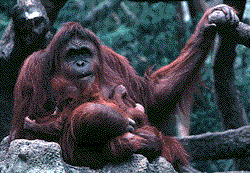ORANGUTAN
Pongo pygmaeus
Mammal
Order Primata
Description
3.5 - 4.4 feet tall, 90-200 pounds, males larger. Sparse, long, red hair varies in shade from bright orange (young) to maroon and brown (adults). Face hairless and black, but lighter on muzzle and around eyes in young. Sumatran subspecies has a thinner, longer face, longer hair and paler color than Borneo subspecies. Adult males have cheek flanges of fibrous tissue (especially Bornean), and enlarged throat pouch and very long hair. Long arms with hook-shaped hands and feet. Hybrids exist in zoos.
Range
Northern Sumatra and most of lowland Borneo.
This species is listed as endangered and commercial trade of this species is prohibited by international law. Decreasing numbers are due to logging of the tropical rainforest. A number of reserves exist in both Sumatra and Borneo as a short-term effort to preserve the species. Long-term efforts must concern rational management of rainforests. Lincoln Park Zoo is a member of the Siberian tiger Species Survival Plan.
Photo © James P. Rowan

 Ecology
Ecology
- Habitat
- Lowland and hilly tropical rainforest.
- Niche
- Principally herbivorous: eats mostly fruits, leaves and shoots, but will also eat insects, mineral-rich soil, tree bark, eggs and small vertabrates. Travels slowly by day in search of food. Solitary and arboreal, but large males will travel along the ground, and young are quite social. Males are territorial.
Life History
Single young born after about 9 months gestation. Weaned at about 3 years, mature at about 10 years. Infants ride on mother several years, but are usually independent by maturity. Life span 35 years, up to 50 in captivity.
Special Adaptations
- Long arms with hook-shaped hands and feet aid in brachiation and climbing as well as feeding.
- Massive teeth and jaws designed to tear open fruit shells, hard nuts and bark as well as grind tough vegetation.
- High intelligence probably an adaptation to finding scarce or isolated fruit plants in the rainforest. A good memory for time and place and ability to make decisions are essential in predicting food locations.
- Adults use heavy weight of their bodies to swing trees back and forth until they can reach across gaps between trees.
- Cheek flanges and long hair of adult males aid in aggressive displays toward rival males.
- Male's throat pouch inflated during calling adds resonance to longmorning calls. These may be territorial calls, sexual display calls or position signals used as a spacing function.


